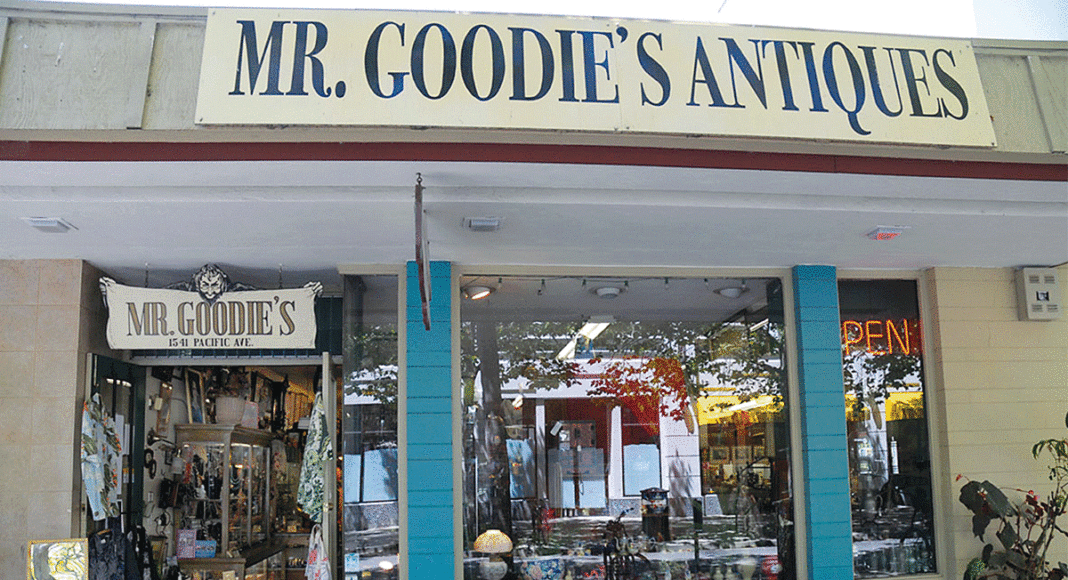As the 1989 Loma Prieta Earthquake violently shook Santa Cruz County with magnitude-6.9 force, a Champagne bottle in Mr. Goodie’s Antiques and Collectibles on Pacific Avenue rattled alongside dozens of fragile relics, each dancing inside their glass enclosures. While many buildings crumbled or faced such irreparable harm that they would later be torn down, the one-story Mr. Goodie’s building—a newer and stronger design than surrounding structures—did not fail.
“We were saving that bottle to celebrate our opening,” remembers co-owner Kurt Haveman, also known as “Mr. Goodie,” who runs the shop with his wife and business partner, Kit. “It survived!” he happily shouts from behind the shop counter, where tribal masks and vintage clocks surround him. “We still have it in the back.”
At the end of March, the Havemans will close up their one-of-a-kind antique shop after 28 years of business in downtown Santa Cruz.
“I’m happy for Kit and Kurt, because it’s time for them to retire and move on,” says Richard Hoffman, a longtime customer and friend of the Havemans who often visits the shop in search of Native American memorabilia. “But the thought of moving all this stuff,” says Hoffman, his voice quieting as his eyes widen and scan the store’s many glass cases. “It’s a little overwhelming.”
When customers walk through Mr. Goodie’s doors, they find items from just about any era—from Napoleonic helmets to 1950s potato mashers. The Havemans have a long history in dealing antiques. Before becoming “Mr. and Mrs. Goodie,” they ran a business designing and implementing themes for restaurants with old-fashioned decor. But hauling antiques and five children across the country proved exhausting, so, in 1974, the family settled in Santa Cruz, where they moved into and began revamping their downtown Victorian.
A decade later, they began a 27-person collective of antique dealers, called Moderne Life, just five doors down from their current storefront. But the couple wanted to sell items that were older than Moderne Life’s scope, which focused on mid-century items. So they opened Mr. Goodie’s in 1989 with Ed Doran and Rocky Wagers (who both later retired in 2009). The earthquake came 17 days later, destroying the Moderne Life building, yet leaving Mr. Goodie’s intact.
Haveman sent his nine-year-old daughter outside with a sign made of sandwich board telling everyone they were still open. Business was slow to return, as he remembers, after the quake decimated downtown. To make ends meet, Kit took a side job waitressing at Ristorante Avanti. It took several years before their customer base returned.
The Havemans say they’re closing their doors only because they’re eager to enjoy their next adventure—namely, traveling across the country to see family, friends and, of course, more antiques.
Meanwhile, many antique stores around the world have closed in recent years for financial reasons.
“Antique stores can’t just rely on people walking in the door,” says pop culture memorabilia appraiser Leila Dunbar, who has appraised items for the Antique Roadshow. “They have to be aggressive in marketing through the internet,” she adds.
Some observers think the antique industry faces other obstacles, as well. An article in the Economist from 2015 offered that buyers are simply less interested in the sometimes fickle world of antiques than they were even a decade ago. The magazine also suggested—as some experts also have—that, while higher-end antiques continue to perform well, everyday vintage goods generally have not.
Haveman says that the real value in an antique lies in a sense of nostalgia. “People want things from their childhood they couldn’t afford,” he says.
That’s certainly what Bonnie Belcher, promoter of the Downtown Antique Faire, was trying to tap into when she first began collecting more than 35 years ago.
“It all started when I wanted to replace things I remembered from my childhood,” she says. “To find something from that time or something my grandmother had owned, it’s a great feeling.”
Beyond reliving the past, collectors like the Havemans can use their love of old items to share something with the people they meet every day.
Haveman loves to tell stories, and when a young woman brings a cast-iron pot to the counter and asks the price, he recounts how cross-country truckers would leave these same pots—uncooked meals enclosed—in their hot engine bays. At the end of their shift, says Haveman, a warm meal waited under the hood.
Across the nation, as an uncertain future looms for antiques, enthusiasts in Santa Cruz see reason to remain optimistic. “I don’t see the love or want of antiques going anywhere for a long time,” says Belcher.
Attendance at the Downtown Antique Faire is strong, she notes, and Santa Cruz is one of few California cities to host such a monthly fair—on the second Sunday of each month.
“I really hope we continue having people who enjoy antiques and collectibles here,” she says, “people who keep things for another generation that, hopefully, they can enjoy.”













